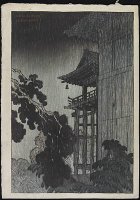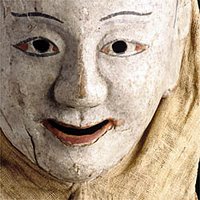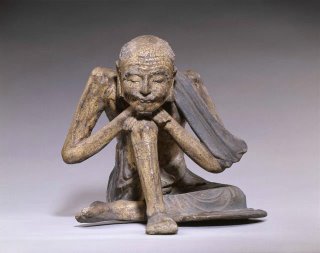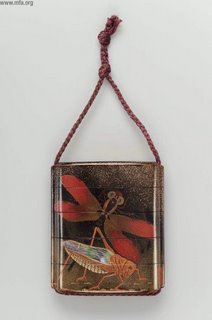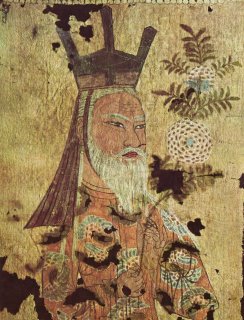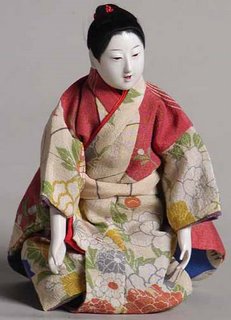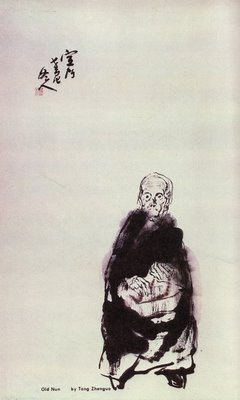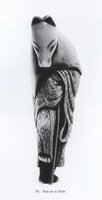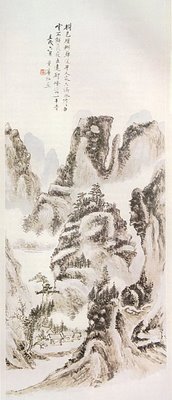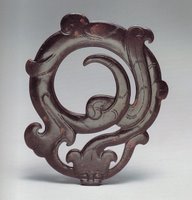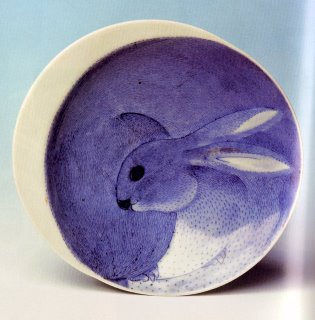 Once upon a time a man was traveling back to his village from a long day at a local market. He was late and unfortunately found himself in the middle of the forest when the sun set.
Once upon a time a man was traveling back to his village from a long day at a local market. He was late and unfortunately found himself in the middle of the forest when the sun set.Being nervous of walking at night, he found a hollow in a big tree by the track and snuggled in for the night. He slept lightly as he was unused to sleeping with the sounds of the night so close and the ground seamed to itch him so that he fidgeted under his kimono.
As time wore on into the blackest part of the night he began to drift into the restful part of dreaming, however just as he was to slip into unconsciousness a noise caught his attention. He thought he had heard a voice. Then he heard another. And then more voices. He was wide awake now and very frightened. "Who could it be carousing through the forest in the middle of the night?" he thought.
He peeped out of the hole in the tree and saw a gang of elves had set up a party next to his tree by the track and were bringing out bottles of sake and food. They danced and sang in the most amusing way and so that after a while he forgot all about his fear and crept out of his hole and took his turn at the sake cup and sang and played with the elves of the forest.
The next morning just before the sun broke the night into day, the elves congratulated the man on his inspired drinking games and for teaching them new songs and dances. Hoping to have him return, and being elves and so by nature tricksters, they took what they thought to be something precious to the man in order to secure his return. What they took however was a big red wen that had been an embarrassing birth mark on his head. The man couldn't believe his luck at being so transformed!
When he arrived in his village, his changed appearance caused quite a deal of interest and soon a large circle of people gathered around his front door to hear his remarkable tale. His neighbour seemed particularly keen and remained to hear the tale told many times. He even asked very particular questions like just exactly which tree he had stopped at and asked if he would be able to judge what time it was that the elves appeared. This was all very curious but after a while everyone went back to their homes and got on with their business. All, except the neighbour that is. He went back to his house and prepared a travel pack. When all was quite, he slipped out of the village and into the forest to find the elves.
Now, why in heaven would he do such a thing? Well, you see he also had a red wen on his head and he thought that if he dined and supped with the elves that they would take his wen too.
He hid in the hollow of the tree that had been described and he waited until the very dead of night. The elves came and began their nightly revel and so, even though he was white with fear, he crept forward taking the sake cup handed to him by one of the frightful elves. In the morning the elves thanked their guest for coming back to play with them. You see, they had mistaken the neighbour for the man of the night before. "Since you have been so good to return to us as you promised, we will return to you the treasure we took last night," said the head elf. The neighbour was at a loss as to what treasure they meant as the man had not mentioned any treasure in his tale, but the neighbour replied he was eager for his treasure to be returned. Suddenly, the elves disappeared as the sun had broken the spell of night and the neighbour found himself confused and alone without the promised treasure, or so he thought.
 He stumbled back to the village disappointed, with a heavy head and a blurry eye. As he walked passed the people of his village, they all started to stare at him in the most peculiar way and some even started laughing behind their sleeves. "What could all this mean?" he thought. When people began to point at his head and run to get others, he decided to see for himself what was the matter with him. He leaned over the edge of a duck pond that was close by and gasped at what he saw. His wen had grown to twice its size! Now, he knew that the treasure was the wen of his neighbour and the elves had kept their devilish promise. He cried out loud and fled home to his house. He did not come out for a very long time.
He stumbled back to the village disappointed, with a heavy head and a blurry eye. As he walked passed the people of his village, they all started to stare at him in the most peculiar way and some even started laughing behind their sleeves. "What could all this mean?" he thought. When people began to point at his head and run to get others, he decided to see for himself what was the matter with him. He leaned over the edge of a duck pond that was close by and gasped at what he saw. His wen had grown to twice its size! Now, he knew that the treasure was the wen of his neighbour and the elves had kept their devilish promise. He cried out loud and fled home to his house. He did not come out for a very long time.********
 The Elves and The Envious Neighbour has been adapted from the tale of that name from the book, "Tales of Old Japan
The Elves and The Envious Neighbour has been adapted from the tale of that name from the book, "Tales of Old JapanThis is a very funny story and when I came across the Kyogen mask with the wen (wen is a benign tumor of the skin) I knew I had to adapt this tale for Crackle Mountain.
Images:
Image 1: Oni in a tug of War, attributed to Hasegawaw Mitsunobu, from "Toba-e fude byoshi" (Comic Pictures in Rhythmic Brushplay. 1772) Vol. 2. Woodblock printed book, 25.4 x 18 cm. This is image has been scanned from the book "", Edited by Stephen Addiss, George Braziller, New York, 1985, in association with the Spenser Museum of Art, University of Kansas.
Image 2: Japanese Kyogen Mask, from Masks of the World.
Image 3: Noh Mask; Humans and Fox Netsuki, unknown artist, ivory with inlay, height 5.1 cm. Spenser Museum of Art: William Bridges Thayer Memorial, 28.355. Scanned from the book "Japanese Ghosts and Demons: The Art of the Supernatural
Tags:


